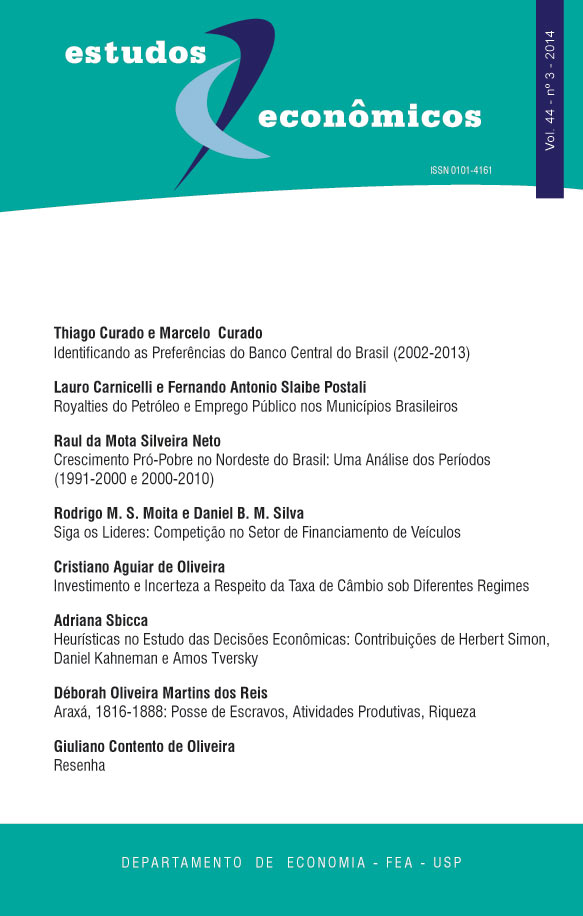Follow the leaders: competition in the Brazilian auto financing sector
DOI:
https://doi.org/10.1590/S0101-41612014000300004Palavras-chave:
reaction functions, auto financing, leader-follower game, market powerResumo
This study seeks to understand the competitive pattern and strategy of the firms in
the Brazilian automobile financing market. First, we analyzed the strong segmentation
observed in this market, determining market niches. We then estimated reaction functions
to price changes. The results indicated that the three largest companies in the
sector have a strong influence on interest rate setting within the entire segment. This
phenomenon characterizes the competition of this sector as the leader-follower type,
rather than Bertrand competition, the latter of which is often expected in the banking
sector and it demonstrates the existence of the leading firms’ market power.
Downloads
Referências
AFANASIEFF, T. S., LHACER, P. M. V., & NAKANE, M. (2001). Determinants of Bank Interest
Spreads in Brazil. 2001. Available at: . Accessed on 14/10/2011.
ALLEN, F., BARTIROLO, L., & KOWALESWSKI, O. (2006). The Financial System of the EU 25.
Wharton Working Paper.
BAYE, M., & MORGAN, J (2002). Winner-take-all price competition. Economic Theory, 19.
BELAISCH, A. (2003). Do Brazilian Banks Compete? IMF Working Paper.
CLAESSENS, S., & LAEVEN L. (2008). What Drives Bank Competition? Some International Evidence. Journal of Money, Credit and Banking, v. 36, no. 3.
COTTERILL, R. W., & PUTSIS, W. R. (2000). Market Share and Price Setting Behavior for Private
Labels and National Brands. Review of Industrial Organization, 17(1): 17-39.
COUGHLAN, A. T., & MANTRALA, M. K. (1994). Dynamic Competitive Retail Pricing Behavior
with Uncertainty and Learning. Managerial and Decision Economics, 15:3-20.
DHAR, T., CHAVAS, J., COTTERILL, R. W., & GOULD, B. W. (2005). An Econometric Analysis of
Brand-Level Strategic Pricing between Coca-Cola Company and PepsiCo. Journal of Economics
and Management Strategy, 14(4): 905-931.
FERREIRA, C. F. (2005). Estrutura, concorrência e performance do setor bancário em um mercado heterogêneo. Thesis (Ph.D. in Economics) presented to the College of Economics, Administration and Accounting of the University of São Paulo. São Paulo.
FUDENBERG, D., & LEVINE, D. K. (1999). The Theory of Learning in Games. Cambridge: MIT Press.
GREENE, W. H. (2008). Econometric Analysis. 6. Ed. New Jersey. Prentice Hall.
HO, Teck-Hua, CAMERER, C., & WAIGELT, K. (1998). Iterated Dominance and Iterated Best Response in Experimental “p-beauty contests”. The American Economic Review, 88: 947-969.
KOTLER, P. (2000). Administração do Marketing. 10. ed. São Paulo: Prentice Hall.
KOYAMA, S. M., & NAKANE, M. (2002). Os Determinantes do Spread Bancário no Brasil. Notas
Técnicas do Banco Central do Brasil. n. 19, abril 2002. Available at: . Acessed
on: 14/10/2011.
LAZZARINI, S. G., ARTES, R., MOURA, M. L., & FUKUDA, F. R. (2006). Inteligência Competitiva na
Prática: Métodos para Estimar e Analisar Reações de Competidores. In: Delane Botelho; Deborah Moraes Zouain. (Org.). Pesquisa Quantitativa em Administração. Volume 1, Atlas, São Paulo.
LIANG, J. (1989). Price Reaction Functions and Conjectural Variations. Review of Industrial Organization, 4(2): 31-58.
MADDALA, G.S., & WUS. A. (1999). A Comparative Study of Unit Root Test with Panel Data Simple New Test. Oxford Bulletin of Economics and Statistics, 61: 631-652.
MÁLAGA, T., MAZIERO, P., & WERLANG, S. R. da C. (2011). Estudo de Rentabilidade Bancária.
Banco Itaú. Consultoria Econômica. Available at <http://www.febraban.org.br>. Acessed on
/08/2011.
MARCO, S. A. (1999). Inteligência competitiva: definições e contextualização. Revista Transinformação do Departamento de Pós-graduação de Biblioteconomia, PUC de Campinas, 11: 95-102.
MESAK, H. I., & CLELLAND, R. (1979). A Competitive Pricing Model. Management Science, 25:
-1068.
MONTGOMERY, D. B., MOORE, M. C., & URBANY, J. E. (2005). Reasoning about Competitive
Reactions: Evidence from Executives. Marketing Science, 24: 138-149.
MOURA, M. L., ARTES, R., LAZZARINI, S. G., Caetano, Marco Antonio Leonel, & Goldberg, Marcelo B. (2008). Does it Pay to Anticipate Competitor Reactions? International Journal of Business and Economics, 7: 192-204.
MURRAY, I. W., & RICKARD, J. A. (1978). The Dynamics of Some Discrete Time Duopoly Price
Games Involving Cournot and Related best-response Strategies. Economica, 45: 297-303.
NAGLE, T. (1984). Economics Foundations for Pricing. The Journal of Business, 57: S3-S26.
NAKANE, M. I. A Test of Competition in Brazilian Banking. n. 12, mar. 2001. Central Bank of Brazil Working Paper. Acesso em: 24/12/2011.
OZAWA, C. Y. (2008). Estudos empíricos sobre a microeconomia bancária no Brasil. Thesis (Ph.D.in Economics) presented to the College of Economics, Administration and Accounting of the University of São Paulo, São Paulo.
PETTERINI, F. C., & JORGE NETO, P. M. (2003). Competição Bancária no Brasil após o Plano Real, CAEN Working Papers.
VICKNER, S. S., & DAVIES, S. P. (1999). Estimating Market Power and Pricing Conduct in a Product-Differentiated Oligopoly: The Case of the Domestic Spaghetti Sauce Industry. Journal of Agricultural and Applied Economics, 31(1): 1-13.
Downloads
Publicado
Edição
Seção
Licença
Copyright (c) 2014 Rodrigo Menon Simões Moita, Daniel Silva

Este trabalho está licenciado sob uma licença Creative Commons Attribution-NonCommercial 4.0 International License.
A submissão de artigo autoriza sua publicação e implica o compromisso de que o mesmo material não esteja sendo submetido a outro periódico.
A revista não paga direitos autorais aos autores dos artigos publicados.





 Atualizado em 14/08/2025
Atualizado em 14/08/2025